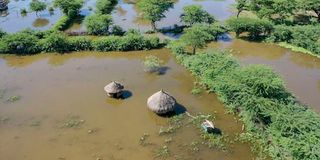Climate change fuels infectious diseases

Salabani village where the rising water levels of Lake Baringo have now flooded displacing entire villages near Marigat, Baringo County on October 6, 2020.
With the climate crisis, infectious diseases threaten global health. Changes in average temperatures, humidity levels, vegetation quality, and the movement of animals influence arthropod distribution patterns.
For instance, the range of activity of malaria-transmitting mosquitoes increases exponentially as global average temperature rises. Insect vectors are exceptional at transmitting disease, accounting for 30 per cent of all new diseases in the last decade.
Pollution and declining air quality increase vulnerability to infectious respiratory diseases. The Sars virus in China in 2002, for example, disproportionately affected those from areas with higher levels of air pollution, who had twice the risk of dying from the disease as those from places with better air quality.
About 75 per cent of all diseases that have threatened humanity around the turn of the century have been zoonotic.
Centers for Disease Control say that three out of every four novel or emerging diseases originate in animals, a fact that has been proved in the case of Covid-19, according to a research published in Nature. And a 2009 USAid Predict Project assessment found that at least 931 different viruses have transmitted from animals to humans in the last decade, with the number likely to rise as a result of extensive deforestation, forest razing, and other human effects.
In fact, a study published in Nature demonstrated that contagious viruses actually grow faster in damaged ecosystems. What’s more, environmental shocks increase the expression of virulence, transmission, and survival factors in highly infectious gram-negative bacteria.
Fungi offer an equal or even greater threat. There are no jabs yet for fungal infections.
The antifungal arsenal is relatively limited. And fungi can survive saprotrophically, producing enormous quantities of infectious spores. While the ability to grow at high temperatures makes many species incapable of infecting and establishing in humans, fungi can acquire thermotolerance, and gradual adaptation to rising temperatures could result in more highly pathogenic species.
Climate change may also expand their geographic range (or for their vectors), resulting in widespread diseases.
For instance, floods, storms, and hurricanes can disperse and aerosolise them, or get them implanted through traumatic wounds.
To reduce the effects of climate change on infectious disease transmission, a three-prong strategy is necessary.
This includes assessing evidence from previous infectious diseases and climate change, examining new pathogenic infections across time, and constructing prediction models to anticipate future disease burden under various climate change scenarios.
Charles Onyango, Nairobi





